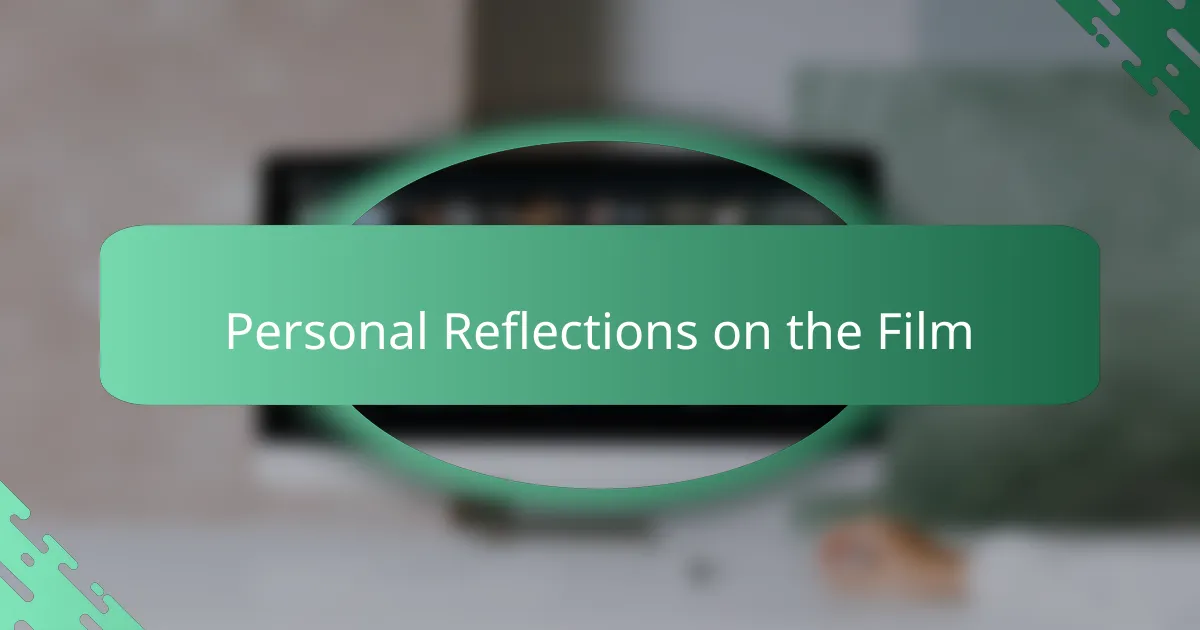Key takeaways
- “The 400 Blows” explores themes of freedom, individuality, and alienation, resonating with audiences across generations.
- François Truffaut’s innovative cinematography and storytelling techniques create a deep emotional connection with the protagonist, Antoine Doinel.
- The film’s portrayal of adolescence and family dynamics reflects ongoing challenges faced by today’s youth, promoting empathy and understanding.
- Key lessons from the film include the importance of nurturing environments and resilience in overcoming personal struggles.

Understanding French cinema impact
French cinema has always captivated audiences, and engaging with “The 400 Blows” is a perfect example of this. I felt a profound connection to the film’s raw depiction of youth and rebellion. The way François Truffaut highlights the struggles of adolescence resonated deeply with my own experiences, evoking emotions that lingered long after the credits rolled.
What I find particularly fascinating is how French cinema often breaks conventional storytelling norms, allowing for a more introspective approach. The lasting impact of films like “The 400 Blows” can be seen in modern filmmaking, where character depth and emotional resonance are prioritized over mere plot mechanics. It prompts me to reflect on how storytelling can evoke empathy and understanding across different cultures.
Here’s a comparison of “The 400 Blows” with contemporary films that draw from its themes:
| Film | Themes |
|---|---|
| The 400 Blows | Adolescence, Freedom, Rebellion |
| Dead Poets Society | Individualism, Inspiration, Youth |
| Lady Bird | Coming-of-age, Family Ties, Independence |

Overview of The 400 Blows
“The 400 Blows,” directed by François Truffaut, is a stunning portrayal of adolescence and rebellion. Set in post-war Paris, it follows the life of a young boy named Antoine Doinel, who feels increasingly alienated from his family and society. I remember the first time I watched it; I was struck by how deeply Antoine’s frustrations resonated with my own teenage experiences of feeling misunderstood.
The film is not just a story about a boy; it’s a poignant exploration of freedom and the inevitable search for identity. Watching Antoine navigate his harsh reality made me reflect on my own quest for acceptance, which felt that much more significant in a world often indifferent to youth.
- A semi-autobiographical work reflecting Truffaut’s own childhood experiences.
- Notable for its innovative storytelling techniques and use of natural light.
- Captured the essence of French New Wave cinema, influencing countless filmmakers.
- Compelling character arc of Antoine, showcasing the complexities of adolescence.
- Evokes deep empathy for its protagonist through raw and honest storytelling.

Major themes in The 400 Blows
One of the major themes in “The 400 Blows” is the struggle for freedom and individuality. I remember watching Antoine Doinel, the protagonist, desperately seeking liberation from his stifling home life and oppressive school environment. This theme struck a chord with me, as I reflected on my own childhood experiences of grappling with authority and the quest for personal identity.
Another central theme is the theme of alienation. Antoine often feels disconnected from his parents and peers, and I found myself empathizing with his sense of isolation. It reminded me of times when I also felt misunderstood and alone, highlighting how universal this feeling can be across different stages of life.
Lastly, the film captures the bittersweet nature of adolescence. Antoine’s innocent yet rebellious actions depict the ups and downs of growing up. I believe that this theme resonates with anyone who has experienced the tumult of teenage years, filled with both hope and disappointment.
| Theme | Description |
|---|---|
| Freedom and Individuality | Antoine’s struggle against societal constraints reflects the universal quest for self-discovery. |
| Alienation | Antoine’s disconnectedness emphasizes the challenges of feeling misunderstood in adolescence. |
| Bittersweet Nature of Adolescence | The film illustrates the joys and hardships of growing up, resonating with anyone’s past experiences. |

Artistic techniques used in The 400 Blows
One of the most striking artistic techniques in “The 400 Blows” is its innovative use of cinematography. The film often employs long takes and a handheld camera style, which helps create an intimate connection with the protagonist, Antoine Doinel. I remember feeling as if I were right there with him, experiencing the ups and downs of his youthful rebellion and disillusionment.
The film’s use of natural lighting enhances its realism, immersing the audience in the everyday life of Paris. I found myself captivated by the authenticity of the settings, which reflected the gritty yet poetic aspects of Antoine’s world. It’s remarkable how François Truffaut’s use of space and framing not only tells a story but also evokes deep emotions, making the viewer resonate with Antoine’s struggles.
Additionally, the poignant score by Jean Constantin complements the visuals beautifully, underscoring the protagonist’s emotional journey. I often replay those scenes in my mind, remembering how the music echoed the bittersweet nature of growing up.
| Artistic Technique | Description |
|---|---|
| Cinematography | Long takes and handheld camera create intimacy. |
| Natural Lighting | Authentic settings reflect gritty reality. |
| Musical Score | Complementary music heightens emotional impact. |

Personal reflections on the film
I remember the first time I watched “The 400 Blows.” The storytelling felt incredibly intimate, drawing me into the world of young Antoine Doinel. I could relate to his struggles and sense of alienation, reminding me of my own teenage years when it often felt like no one understood me.
The stark reality of Antoine’s life contrasted with my own experiences, but I found a connection in his desire for freedom and understanding. Each frame captured a rawness that resonated deeply, making me reflect on the universal struggles of growing up. It was the film’s emotional depth that lingered with me long after the credits rolled.
Below is a comparison table that encapsulates key aspects of the film:
| Aspect | Details |
|---|---|
| Director | François Truffaut |
| Year Released | 1959 |
| Main Character | Antoine Doinel |
| Theme | Alienation and Adolescence |
| Notable Technique | Handheld Camera Work |
| Cinematic Style | French New Wave |

How The 400 Blows resonates today
The themes in “The 400 Blows” resonate powerfully today, particularly in our understanding of youth and the struggles that come with it. As I reflect on the film, I remember my own turbulent teenage years, marked by feelings of isolation and rebellion. Just like Antoine Doinel, I often felt misunderstood, grappling with expectations that felt stifling rather than supportive.
In a world where adolescents still navigate complex family dynamics and societal pressures, “The 400 Blows” serves as a poignant reminder of the universal quest for identity and acceptance. It’s fascinating how Truffaut’s exploration of emotional depth continues to evoke empathy, encouraging us to look deeper into the lives of young people today.
- Portrayal of adolescence: It captures the confusion and rebellion of youth in a relatable way.
- Family dynamics: The impact of parental relationships mirrors many contemporary struggles.
- Emotional resonance: The feelings of alienation depicted still reflect the experiences of many teenagers today.
- Quest for identity: The film highlights the ongoing journey many young people face in defining themselves.
- Contextual parallels: Social issues from the 1960s align with modern youth challenges, such as mental health and peer pressure.

Lessons learned from The 400 Blows
Engaging with “The 400 Blows” has taught me the importance of empathy in storytelling. The film’s depiction of Antoine Doinel’s struggles really resonated with me. I found myself reflecting on my own experiences of growing up and feeling misunderstood.
One of the key lessons is the impact of a nurturing environment. Watching Antoine’s turbulent family life made me appreciate the small moments of support that helped shape my own path. It really struck me how vital it is for young people to have a guiding hand.
I also learned about the power of resilience. Despite the challenges Antoine faced, his journey showcases an innate drive to seek freedom and understanding. This reminds me of my own challenges and how perseverance can lead to personal growth.
| Lesson | Personal Insight |
|---|---|
| Empathy in Storytelling | Understanding characters through their struggles can deepen our human connection. |
| Nurturing Environments | A supportive background can make a significant difference in one’s journey. |
| Resilience | Overcoming adversity fosters growth and self-discovery. |
